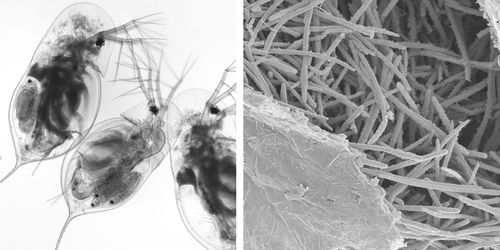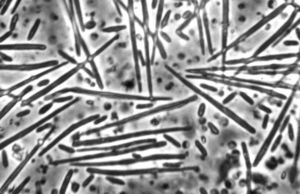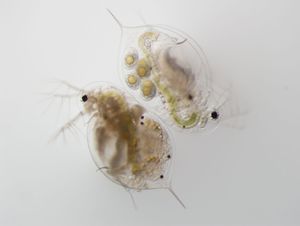Metschnikowia bicuspidata: Difference between revisions
(Created page with "{{Uncurated}} ==Classification== Domain; Phylum; Class; Order; family [Others may be used. Use [http://www.ncbi.nlm.nih.gov/Taxonomy/ NCBI] link to find] ===Species=== {| ...") |
|||
| (87 intermediate revisions by 2 users not shown) | |||
| Line 1: | Line 1: | ||
{{Uncurated}} | {{Uncurated}} | ||
==Description and Significance== | |||
[[File:Metschnikowia_bicuspidata_spores.jpeg|300px|thumb|right|Haploid ascospores of Metschnikowia bicuspidata. Photo by Dieter Ebert.]] | |||
[[File:Metschnikowia_infected_daphnia_photo_by_duffy.jpeg|300px|thumb|right|An infected Daphnia dentifera (left) and an uninfected Daphnia dentifera (upper right). Embryos are clearly visible in the brood pouch on the uninfected animal's back. Photo by Meghan Duffy.]] | |||
''Metschnikowia'' are single-celled fungal parasites of freshwater animals [7]. It typically parasitises crustaceans, including ''Daphnia'', a genus of zooplankton [7]. ''M. bicuspidata'' has also been found to infect prawns and salmon [6]. | |||
The organism has two morphological forms: round vegetative cells and single-celled needle-shaped propagative spores [7]. | |||
''M. bicuspidata'' uses energy from the host ''Daphnia'' to produce tens of thousands of identical haploid spores. These increase in number until the ''Daphnia'' is killed and its carapace ruptures, introducing tens of thousands of new spores into the water column. | |||
== | ''Daphnia'' and ''M. bicuspidata'' are used in ecology and evolutionary biology to study ecological phenomena in aquatic ecosystems. ''M. bicuspidata'' is used to study host-parasite dynamics and the effects of parasitism on host community evolution. | ||
==Classification== | |||
{| | {| | ||
| Line 11: | Line 21: | ||
|} | |} | ||
'' | Domain: Eukaryota, Kingdom: Fungi, Dikarya, Ascomycota, Saccharomycotina, Saccharomycetes, Order: Saccharomycetales, Family: Metschnikowiaceae, Genus: ''Metschnikowia'', Species: ''M. bicuspidata'' [1]. | ||
There are three varieties in the species: ''M. bicuspidata'' var. ''bicuspidata'', var. ''californica'', and var. ''chathamia'' [7]. | |||
==Genome Structure== | ==Genome Structure== | ||
The genome of ''Metschnikowia bicuspidata'' NRRL YB-4993 is 16.06 Mbp long. Being a eukaryote, this parasite's DNA is linear. This genome of this species contains 1376 genes associated with cellular processes and signaling, 1088 genes associated with information storage and processing, 1237 genes associated with metabolism, and 877 genes that are poorly characterized. | |||
26S statistics for ''M. bicuspidata'' var. ''bicuspidata'' show an average similarity between strains to be 99.3%, while var. ''chathamia'' has an average similarity of 98.6% between strains. | |||
==Cell Structure, Metabolism and Life Cycle== | ==Cell Structure, Metabolism and Life Cycle== | ||
''M. bicuspidata'' is a chemoorganoheterotroph, and uses energy from the ''Daphnia'' body to reproduce [5]. | |||
''M. bicuspidata'' variants can be determined by their metabolic activities. ''M. bicuspidata'' var. ''californica'' has the ability to assimilate methyl-α-D-glucoside, D-gluconate and s-Keto-D-gluconate. ''M. bicuspidata'' var. ''chathamia'' can assimiliate methyl-α-D-glucoside, but cannot assimilate D-gluconate or 2-keto-D-gluconate. ''M. bicuspidata'' var. ''bicuspidata'' is unable to assimilate D-glucoside. | |||
The life cycle proceeds as follows: Needle-shaped cells (haploid, n) float in the water column and are eaten by Daphnia. In the Daphnia hemolymph, these cells reproduce asexually to form spherical vegetative cells (haploid, n) that undergo plasmogamy (forming one cell containing two separate haploid nuclei. written in shorthand: n + n). After a delay, karyogamy occurs, resulting in a single diploid cell (2n). This diploid cell may undergo asexual mitotic haploidization, yielding vegetative haploid spherical cells. Alternatively, the diploid cell may undergo sexual meiotic haploidization, yielding haploid propagative needle-shaped ascospores [7]. The ascospores are the form that persist in the water column and infect hosts [7]. The sharp, needle-like shape of the propagative spores suggest a puncture mechanism for entering through the ''Daphnia'' gut wall. | |||
==Ecology and Pathogenesis== | ==Ecology and Pathogenesis== | ||
[[File:Infected Daphnia healthy Daphnia and SEM Metschnikowia spores.jpeg|500px|thumb|right|From left, an infected Daphnia dentifera, an uninfected D. dentifera, and an infected D. dentifera. Photo by A. J. Tessier. On right, a scanning electron microscopy image showing M. bicuspidata spores as they appear under the ruptured carapace of an infected zooplankter. Photo by Carol Flegler. [5].]] | |||
Exposure of a host to parasitic ''M. bicuspidata'' occurs during feeding. ''Daphnia'' eat algae in the water column, feeding indiscriminately on whatever floating particles fit into their mouths. ''M. bicuspidata'' spores may enter the ''Daphnia'' gut and puncture the gut wall. Infection begins when the fungus begins reproducing in the ''Daphnia'' hemolymph [4]. <br> | |||
Symptoms of infection include reduced fecundity (in ''D. magna'') [4]. Infection in other animals, for example, prawn and salmon, produces symptoms including altered tissue coloration, edema, inflammation in muscles, swollen organs, necrotic lesions, and early death [2][3]. The prawn contained yeast at approximately 10(8) to 10(9) colony forming units per 100 mg of tissue [3]. | |||
Susceptibility to infection varies across host genotypes. ''M. bicuspidata'' kills one host, ''D. magna'', in 7-25 days (average = 17.5 days); for comparison a healthy ''D. magna'' typically lives 40-80 days [4]. | |||
Virulence depends on the quality of food eaten by the host ''Daphnia'' [5]. When feed more food or good-quality food, infection proceeds more rapidly and ''Daphnia'' die faster [5]. When food quality or quantity is low, infected ''Daphnia'' survive for a longer period of time [5]. | |||
Upon death due to infection, ''Daphnia'' may yield 10,000 to 70,000 spores per individual [8]. | |||
Transmission is horizontal, meaning infection occurs within a host generation and is not transmitted from parent to offspring [4]. | |||
''M. bicuspidata'' can survive at temperatures of 9-27 degrees C, salinity of 270 ppt, and NaCl concentrations of 0-180 ppt [6]. (For comparison, sea water salinity is approximately 35 ppt). | |||
==References== | ==References== | ||
[ | |||
[1] [http://www.ebi.ac.uk/ena/data/view/Taxon:Metschnikowia%20bicuspidata%20var.%20bicuspidata%20NRRL%20YB-4993 European Nucleotide Archive. Metschnikowia bicuspidata var. bicuspidata NRRL YB-4993. accessed 21 April 2015.] | |||
[2] [http://kg6ek7cq2b.search.serialssolutions.com.proxyiub.uits.iu.edu/?url_ver=Z39.88-2004&url_ctx_fmt=info:ofi/fmt:kev:mtx:ctx&rft_val_fmt=info:ofi/fmt:kev:mtx:journal&rft.atitle=Metschnikowia%20bicuspidata%20and%20Enterococcus%20faecium%20co-infection%20in%20the%20giant%20freshwater%20prawn%20Macrobrachium%20rosenbergii&rft.aufirst=SC&rft.aulast=Chen&rft.date=2003&rft.epage=167&rft.genre=article&rft.issn=0177-5103&rft.issue=2&rft.jtitle=DISEASES%20OF%20AQUATIC%20ORGANISMS&rft.pages=161-167&rft.spage=161&rft.stitle=DIS%20AQUAT%20ORGAN&rft.volume=55&rfr_id=info:sid/www.isinet.com:WoK:UA&rft.au=Chen%2C%20TH&rft.au=Wang%2C%20PC&rft.au=Chen%2C%20YC&rft.au=Huang%2C%20JP&rft_id=info:pmid/12911064&rft_id=info:doi/10.3354%2Fdao055161 Chen, SC., Chen, TH., Wang, PC., Chen, YC., Huang, JP., Lin, YD., Chaung, HC., Liaw, LL. "Metschnikowia bicuspidata and Enterococcus faecium co-infection in the giant freshwater prawn Macrobrachium rosenbergii." Diseases of Aquatic Organisms. 2003. Volume 55(2). pp. 161-167.] | |||
[3] [http://kg6ek7cq2b.search.serialssolutions.com.proxyiub.uits.iu.edu/?url_ver=Z39.88-2004&url_ctx_fmt=info:ofi/fmt:kev:mtx:ctx&rft_val_fmt=info:ofi/fmt:kev:mtx:journal&rft.atitle=Metschnikowia%20bicuspidata%20dominates%20in%20Taiwanese%20cold-weather%20yeast%20infections%20of%20a%20Macrobrachium%20rosenbergii&rft.aufirst=Shih-Chu&rft.aulast=Chen&rft.date=2007&rft.epage=199&rft.genre=article&rft.issn=0177-5103&rft.issue=3&rft.jtitle=DISEASES%20OF%20AQUATIC%20ORGANISMS&rft.pages=191-199&rft.spage=191&rft.stitle=DIS%20AQUAT%20ORGAN&rft.volume=75&rfr_id=info:sid/www.isinet.com:WoK:UA&rft.au=Chen%2C%20Yu-Chin&rft.au=Kwang%2C%20Jimmy&rft.au=Manopo%2C%20Ivanus&rft.au=Wang%2C%20Pei-Chi&rft_id=info:pmid/17629113&rft_id=info:doi/10.3354%2Fdao075191 Chen, SC., Chen, YC., Kwang, JM., Manopo, I., Wang, PC., Chaung, HC., Liaw, LL., Chiu, SH. "Metschnikowia bicuspidata dominates in Taiwanese cold-weather yeast infections of a Macrobrachium rosenbergii." Diseases of Aquatic Organisms. 2007. Volume 75(3). pp. 191-199.] | |||
[4] [http://kg6ek7cq2b.search.serialssolutions.com.proxyiub.uits.iu.edu/?url_ver=Z39.88-2004&url_ctx_fmt=info:ofi/fmt:kev:mtx:ctx&rft_val_fmt=info:ofi/fmt:kev:mtx:journal&rft.atitle=The%20effect%20of%20parasites%20on%20host%20population%20density%20and%20extinction%3A%20Experimental%20epidemiology%20with%20Daphnia%20and%20six%20microparasites&rft.aufirst=D&rft.aulast=Ebert&rft.date=2000&rft.epage=477&rft.genre=article&rft.issn=0003-0147&rft.issue=5&rft.jtitle=AMERICAN%20NATURALIST&rft.pages=459-477&rft.spage=459&rft.stitle=AM%20NAT&rft.volume=156&rfr_id=info:sid/www.isinet.com:WoK:UA&rft.au=Lipsitch%2C%20M&rft.au=Mangin%2C%20KL&rft_id=info:doi/10.1086%2F303404 Ebert, D., Lipsitch, M., Mangin, K. L. "The Effect of Parasites on Host Population Density and Extinction: Experimental Epidemiology with Daphnia and Six Microparasites." The American Naturalist. 2000. Volume 156(5). pp. 459-477.] | |||
[5] [http://kg6ek7cq2b.search.serialssolutions.com.proxyiub.uits.iu.edu/?url_ver=Z39.88-2004&url_ctx_fmt=info:ofi/fmt:kev:mtx:ctx&rft_val_fmt=info:ofi/fmt:kev:mtx:journal&rft.atitle=Resource%20Ecology%20of%20Virulence%20in%20a%20Planktonic%20Host-Parasite%20System%3A%20An%20Explanation%20Using%20Dynamic%20Energy%20Budgets&rft.aufirst=Spencer%20R.&rft.aulast=Hall&rft.date=2009&rft.eissn=1537-5323&rft.epage=162&rft.genre=article&rft.issn=0003-0147&rft.issue=2&rft.jtitle=AMERICAN%20NATURALIST&rft.pages=149-162&rft.spage=149&rft.stitle=AM%20NAT&rft.volume=174&rfr_id=info:sid/www.isinet.com:WoK:UA&rft.au=Simonis%2C%20Joseph%20L.&rft.au=Nisbet%2C%20Roger%20M.&rft.au=Tessier%2C%20Alan%20J.&rft.au=Caceres%2C%20Carla%20E.&rft_id=info:pmid/19527119&rft_id=info:doi/10.1086%2F600086 Hall, S. R., Simonis, J. L., Nisbet, R. M., Tessier, A. J., Cáceres, C. E. "Resource Ecology of Virulence in a Planktonic Host‐Parasite System: An Explanation Using Dynamic Energy Budgets." The American Naturalist. 2009. Volume 174(2). pp. 149-162.] | |||
[6] Moore, M., and Strom, M. "Infection and mortality by the yeast Metschnikowia bicuspidata var. bicuspidata in chinook salmon fed live adult brine shrimp (Artemia franciscana)." Aquaculture. 2003. Volume 220(1-4). pp. 43-57. DOI: 10.1016/S0044-8486(02)00271-5. | |||
[7] [http://kg6ek7cq2b.search.serialssolutions.com.proxyiub.uits.iu.edu/?url_ver=Z39.88-2004&url_ctx_fmt=info:ofi/fmt:kev:mtx:ctx&rft_val_fmt=info:ofi/fmt:kev:mtx:journal&rft.atitle=Molecular%20and%20genetic%20differentiation%20of%20small-spored%20species%20of%20the%20yeast%20genus%20Metschnikowia%20Kamienski&rft.aufirst=G.%20I.&rft.aulast=Naumov&rft.date=2011&rft.epage=142&rft.genre=article&rft.issn=0026-2617&rft.issue=2&rft.jtitle=MICROBIOLOGY&rft.pages=135-142&rft.spage=135&rft.stitle=MICROBIOLOGY%2B&rft.volume=80&rfr_id=info:sid/www.isinet.com:WoK:UA&rft_id=info:doi/10.1134%2FS0026261711020111 Naumov, G. I. "Molecular and genetic differentiation of small-spored species of the yeast genus Metschnikowia Kamienski." Microbiology. 2011. Volume 80(2). pp. 135-142.] | |||
[8] [http://kg6ek7cq2b.search.serialssolutions.com.proxyiub.uits.iu.edu/?url_ver=Z39.88-2004&url_ctx_fmt=info:ofi/fmt:kev:mtx:ctx&rft_val_fmt=info:ofi/fmt:kev:mtx:journal&rft.atitle=Poor%20resource%20quality%20lowers%20transmission%20potential%20by%20changing%20foraging%20behaviour&rft.aufirst=Rachel%20M.&rft.aulast=Penczykowski&rft.date=2014&rft.eissn=1365-2435&rft.epage=1255&rft.genre=article&rft.issn=0269-8463&rft.issue=5&rft.jtitle=FUNCTIONAL%20ECOLOGY&rft.pages=1245-1255&rft.spage=1245&rft.stitle=FUNCT%20ECOL&rft.volume=28&rfr_id=info:sid/www.isinet.com:WoK:UA&rft.au=Lemanski%2C%20Brian%20C.%20P.&rft.au=Sieg%2C%20R.%20Drew&rft.au=Hall%2C%20Spencer%20R.&rft.au=Ochs%2C%20Jessica%20Housley&rft_id=info:doi/10.1111%2F1365-2435.12238 Penczykowski, R. M., Lemanski, B. C. P., Sieg, R. D., Hall, S. R., Ochs, J. H., Kubanek, J., Duffy, M. A. "Poor resource quality lowers transmission potential by changing foraging behavior." Functional Ecology. 2014. Volume 28. pp. 1245-1255.] | |||
==Author== | ==Author== | ||
Page authored by | Page authored by Katie Griebel and Jacob Gelarden, students of Prof. Jay Lennon at Indiana University. | ||
<!-- Do not remove this line-->[[Category:Pages edited by students of Jay Lennon at Indiana University]] | <!-- Do not remove this line-->[[Category:Pages edited by students of Jay Lennon at Indiana University]] | ||
Latest revision as of 20:37, 6 May 2015
Description and Significance
Metschnikowia are single-celled fungal parasites of freshwater animals [7]. It typically parasitises crustaceans, including Daphnia, a genus of zooplankton [7]. M. bicuspidata has also been found to infect prawns and salmon [6].
The organism has two morphological forms: round vegetative cells and single-celled needle-shaped propagative spores [7]. M. bicuspidata uses energy from the host Daphnia to produce tens of thousands of identical haploid spores. These increase in number until the Daphnia is killed and its carapace ruptures, introducing tens of thousands of new spores into the water column.
Daphnia and M. bicuspidata are used in ecology and evolutionary biology to study ecological phenomena in aquatic ecosystems. M. bicuspidata is used to study host-parasite dynamics and the effects of parasitism on host community evolution.
Classification
|
NCBI: Taxonomy |
Domain: Eukaryota, Kingdom: Fungi, Dikarya, Ascomycota, Saccharomycotina, Saccharomycetes, Order: Saccharomycetales, Family: Metschnikowiaceae, Genus: Metschnikowia, Species: M. bicuspidata [1].
There are three varieties in the species: M. bicuspidata var. bicuspidata, var. californica, and var. chathamia [7].
Genome Structure
The genome of Metschnikowia bicuspidata NRRL YB-4993 is 16.06 Mbp long. Being a eukaryote, this parasite's DNA is linear. This genome of this species contains 1376 genes associated with cellular processes and signaling, 1088 genes associated with information storage and processing, 1237 genes associated with metabolism, and 877 genes that are poorly characterized.
26S statistics for M. bicuspidata var. bicuspidata show an average similarity between strains to be 99.3%, while var. chathamia has an average similarity of 98.6% between strains.
Cell Structure, Metabolism and Life Cycle
M. bicuspidata is a chemoorganoheterotroph, and uses energy from the Daphnia body to reproduce [5].
M. bicuspidata variants can be determined by their metabolic activities. M. bicuspidata var. californica has the ability to assimilate methyl-α-D-glucoside, D-gluconate and s-Keto-D-gluconate. M. bicuspidata var. chathamia can assimiliate methyl-α-D-glucoside, but cannot assimilate D-gluconate or 2-keto-D-gluconate. M. bicuspidata var. bicuspidata is unable to assimilate D-glucoside.
The life cycle proceeds as follows: Needle-shaped cells (haploid, n) float in the water column and are eaten by Daphnia. In the Daphnia hemolymph, these cells reproduce asexually to form spherical vegetative cells (haploid, n) that undergo plasmogamy (forming one cell containing two separate haploid nuclei. written in shorthand: n + n). After a delay, karyogamy occurs, resulting in a single diploid cell (2n). This diploid cell may undergo asexual mitotic haploidization, yielding vegetative haploid spherical cells. Alternatively, the diploid cell may undergo sexual meiotic haploidization, yielding haploid propagative needle-shaped ascospores [7]. The ascospores are the form that persist in the water column and infect hosts [7]. The sharp, needle-like shape of the propagative spores suggest a puncture mechanism for entering through the Daphnia gut wall.
Ecology and Pathogenesis

Exposure of a host to parasitic M. bicuspidata occurs during feeding. Daphnia eat algae in the water column, feeding indiscriminately on whatever floating particles fit into their mouths. M. bicuspidata spores may enter the Daphnia gut and puncture the gut wall. Infection begins when the fungus begins reproducing in the Daphnia hemolymph [4].
Symptoms of infection include reduced fecundity (in D. magna) [4]. Infection in other animals, for example, prawn and salmon, produces symptoms including altered tissue coloration, edema, inflammation in muscles, swollen organs, necrotic lesions, and early death [2][3]. The prawn contained yeast at approximately 10(8) to 10(9) colony forming units per 100 mg of tissue [3].
Susceptibility to infection varies across host genotypes. M. bicuspidata kills one host, D. magna, in 7-25 days (average = 17.5 days); for comparison a healthy D. magna typically lives 40-80 days [4].
Virulence depends on the quality of food eaten by the host Daphnia [5]. When feed more food or good-quality food, infection proceeds more rapidly and Daphnia die faster [5]. When food quality or quantity is low, infected Daphnia survive for a longer period of time [5].
Upon death due to infection, Daphnia may yield 10,000 to 70,000 spores per individual [8]. Transmission is horizontal, meaning infection occurs within a host generation and is not transmitted from parent to offspring [4].
M. bicuspidata can survive at temperatures of 9-27 degrees C, salinity of 270 ppt, and NaCl concentrations of 0-180 ppt [6]. (For comparison, sea water salinity is approximately 35 ppt).
References
[6] Moore, M., and Strom, M. "Infection and mortality by the yeast Metschnikowia bicuspidata var. bicuspidata in chinook salmon fed live adult brine shrimp (Artemia franciscana)." Aquaculture. 2003. Volume 220(1-4). pp. 43-57. DOI: 10.1016/S0044-8486(02)00271-5.
Author
Page authored by Katie Griebel and Jacob Gelarden, students of Prof. Jay Lennon at Indiana University.


